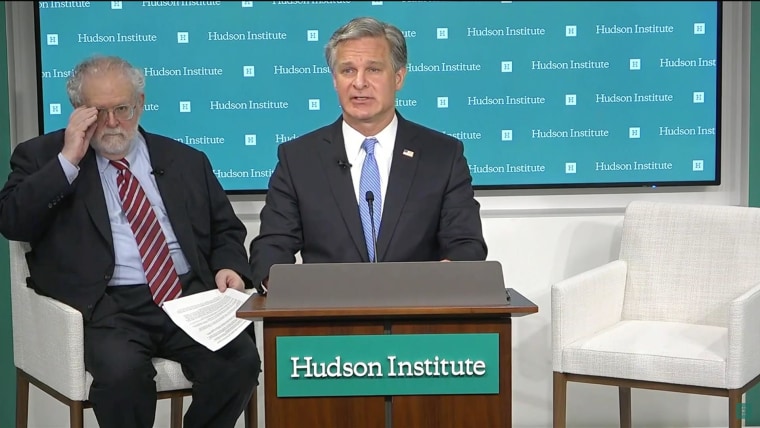
[ad_1]
WASHINGTON — The CIA’s decades-old spying model has been overtaken by technology, according to a former CIA officer who studied the matter for the agency.
“The very idea of a globally dispersed cadre of undercover officers operating in the shadows, away from prying eyes, is obsolete,” said Duyane Norman, who retired in 2019 after a 27-year career at the CIA that included a special project examining the future of espionage.
This week, a cable sent to the CIA workforce, first reported by the New York Times, raised concerns about whether the CIA had been doing enough to protect the informants it recruits in foreign countries.
The cable from the agency’s counterintelligence chief examined dozens of cases in which CIA sources were arrested or executed, the Times reported, and urged officers to focus more on the security of those they convince to spy. The CIA declined to comment on the cable, which NBC News has not seen.
For Norman, the devastating penetrations of CIA spying networks in recent years were not mainly about incompetence or inattention. Instead, he believes they were the logical result of a technology revolution that makes it all but impossible to maintain false identities and disguise relationships.
Norman’s view that the CIA’s traditional human intelligence model can’t survive the digital age is an outlier among his current and former colleagues, but nearly everyone agrees that social media, cell phones, facial recognition technology and super computers that crunch big data have dramatically complicated the business of espionage.
Some of the cases reportedly examined in the cable have been publicized. NBC News reported in 2018, for example, that as many as 20 CIA informants were executed after China compromised a secret communications system the CIA used to talk to sources, with the help of a CIA turncoat recruited to spy for China.
It’s not a new problem. The agency over the years has lost many sources in Iran, American officials have said, and a number of CIA assets were compromised in Lebanon a decade ago thanks in part to cell phone geolocation analysis that allowed Hezbollah spy-hunters to identify people meeting with American operatives. In Milan, an Italian prosecutor was able to identify CIA officers who kidnapped a cleric by sifting through cell phone records.
The main culprit, Norman says, is technology. Everyone spews “digital dust” that reveals key facts about their movements, patterns of life and associations. And the number of sensors spitting out data — phones and cars, thermostats and smart watches — is growing by the year.
The idea that CIA officers can continue to pose as diplomats by day and go out at night to meet and recruit sources using false names — without those agents eventually becoming exposed — is dubious, Norman said.
One example is obvious: How can an American who grew up posting thousands of photos of herself on social media operate in China under an alias, when the Chinese government has a network of surveillance cameras scanning with facial recognition?
But it goes beyond using false names. If a CIA officer is posted abroad pretending to be a business executive or a diplomat, that used to require some detailed backstopping, including fake paperwork and people answering a phone and confirming the cover. Now, it requires much more. An adversary intelligence service is able to paint a picture of that person’s movements and associations and can detect any deviation. If he choses to leave his phone at home, that can also be revealing.
“You need to fundamentally reinvent the business,” Norman said. “If you are in the auto industry and basing the future on a better fossil fuel engine, then you have fundamentally missed the boat of where the auto industry is going.”
Many current and former intelligence officials counter that digital dust can be spoofed, and that nobody is better than American services at using cyber tools to advance human spying.
A senior intelligence official pushed back on the doom and gloom scenario.
“The landscape of course has challenges, but with those challenges also come opportunities,” the official told NBC News. “Human intelligence is very much alive.”
Norman doesn’t dispute the skills of U.S. intelligence agencies. But he doesn’t believe American hackers can keep up with the explosion of sensors and surveillance, especially with the advent of 5G networks and the so-called internet of things, which will usher in a dizzying number of new web-linked devices.
“The number of digital data points on your activities is growing exponentially every year,” Norman said. “You can’t stay ahead of that.”
The House and Senate intelligence oversight committees have been grappling with these issues for years, Congressional officials tell NBC News. And while few go as far as Norman in saying that human intelligence collection as the CIA has done it is finished, many people believe it needs to be substantially re-thought.
“Humint is not dead, but you need to be much more careful,” said former CIA Director John Brennan.
But even careful operations have been exposed by technology.
In 2010, a high-ranking member of Hamas named Mahmoud al-Mabhouh was found dead in his room in a Dubai hotel.
It took less than a month for the Dubai police to expose what they said was a plot by Israeli intelligence to assassinate him, and to assemble videos of the alleged Mossad officers as they entered the hotel. Surveillance camera footage helped the police establish a precise timeline and post photos of dozens of alleged Israeli operatives.
“That entire Israeli team used what we would have considered solid tradecraft,” Norman said. So, he said, did the Russian team that tried to poison a former Russian intelligence officer in Britain in 2018.
But that operation was exposed, not by a foreign intelligence operation, but by Bellingcat, a private group focusing on open-source intelligence.
So what should replace the old model? Norman says he doesn’t have perfect answers, but he believes there must be some level of intelligence collection by American corporations operating abroad. That has been happening as long as the CIA has existed, but to make it a centerpiece of human intelligence would be deeply controversial.
Norman is not alone, however, in believing there needs to be fundamental change.
“The U.S. intelligence community needs a radical reimagining to succeed in this new era,” wrote Amy Ziegart, a senior fellow at the Hoover Institution, recently. “In the past, advantage came from stealing secrets. Secrets still matter, but advantage more and more derives from harnessing open information available to anyone and from human thinking, augmented by machines, that can sift through enormous troves of data to find hidden patterns.”
[ad_2]
Source link



